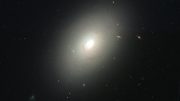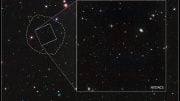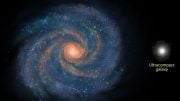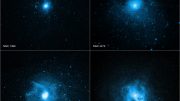
Diagram of stellar orbit statistics for CALIFA galaxies. The higher a galaxy’s position, the larger that galaxy’s fraction of hot (very elongated) orbits. The farther to the right a galaxy’s position, the larger the fraction of cold (nearly circular) orbits. The fact that yellowish elliptical galaxies are mostly top left, while bluish disk galaxies are mostly bottom right indicates the link between stellar orbit statistics and a galaxy’s history. Credit: CALIFA-Team / L. Zhu (MPIA)
This project, in which the Instituto de Astrofísica de Canarias (IAC) is collaborating, has made a map with 300 galaxies close to the Milky Way, which they have classified on the basis of the way the stars are moving, rather than using the morphological classification used until now. The results of this work were recently published in the journal Nature Astronomy.
The objects within galaxies have two basic types of motions: orbiting around the galaxy center in a regular organized disc, or in orbits oriented at random without a clear direction of rotation. If we imagined that galaxies behave in the same way as the Solar System we could think that as the objects move further away from the center their orbital velocities decrease. However, this is not necessarily the case for galaxies, as there are several factors that affect the rotational velocity of these objects, such as the dimensions of the galaxy, the gravitational pull of other galaxies, and the quantity of dark matter in a given galaxy.
An international team of astrophysicists, among them IAC and Universidad de La Laguna researcher Jesús Falcón Barroso, coordinator of the CALIFA (Calar Alto Legacy Integral Field Area survey) at the IAC who is one of the authors of the article published in Nature Astronomy, has collected data from 600 galaxies in the neighborhood of the Milky Way with the Potsday Multiple Aperture Spectrophotometer (PMAS) on the 3.6m telescope at the Calar Alto Observatory (Almería, Spain). As part of this catalog, the scientists have made velocity maps of 300 galaxies showing the movements of their stars. In this way, they have defined three different groups among the sets of stellar orbits, which they have called “cold orbits” “warm orbits” and “hot orbits,” the latter typical of stars with random motions. When they analyzed the data they showed that circular orbits are frequent in lower mass galaxies, while the “hot orbits” are more often found in galaxies with higher mass. In addition, they have found quite a number of “warm orbits,” greater than that previously expected for this type of galaxies.

Four galaxies from the CALIFA survey. The top row shows SDSS images of the galaxies. The center row shows a map of the average stellar velocity within the galaxy; in blue regions, stars are, on average, moving toward us, in red regions, away from us. The bottom row shows whether motion is uniform or mixed – whether stars mostly follow the average motion or whether there are marked deviations from the average. Credit: CALIFA-Team / L. Zhu (MPIA)
Using these maps of stellar motions one can obtain a lot of information about the history of the formation of these galaxies. They evolve and grow over thousands of millions of years, merging with other galaxies. Those which have absorbed other smaller galaxies generally have thin rotating discs, while when two galaxies with similar masses merge an elliptical galaxy is formed, in which the orbits are arranged in random directions. Measuring the orbits in the galaxies analyzed allows us to distinguish between disc galaxies (with colder orbits) and elliptical galaxies (with hotter orbits) even when this difference cannot be detected when using images alone. This implies that by measuring the stellar orbits the researchers will be able to determine if the galaxy we observe is the result of the internal evolution of an isolated object, a relatively calm series of mergers with smaller objects, or the product of a violent merger.
CALIFA, which with its 300 galaxy sample has become one of the biggest archives of data on galaxy dynamics up to now is the “first study to propose a scheme of galaxy classification based on the orbital distribution of their stars, which is different from the classical Hubble diagram, based on morphological classification,” explains Falcón Barroso. This researcher also acknowledges that the results of this study “present some problems for current theories of formation and evolution of galaxies.”
This new classification has been carefully prepared to produce a representative sample that will help astronomers to make models of the evolution of galaxies, and show whether their simulations produce valid predictions.
Reference: “The stellar orbit distribution in present-day galaxies inferred from the CALIFA survey” by Ling Zhu, Glenn van de Ven, Remco van den Bosch, Hans-Walter Rix, Mariya Lyubenova, Jesús Falcón-Barroso, Marie Martig, Shude Mao, Dandan Xu, Yunpeng Jin, Aura Obreja, Robert J. J. Grand, Aaron A. Dutton, Andrea V. Macciò, Facundo A. Gómez, Jakob C. Walcher, Rubén García-Benito, Stefano Zibetti and Sebastian F. Sánchez, 1 January 2018, Nature Astronomy.
DOI: 10.1038/s41550-017-0348-1











Be the first to comment on "CALIFA Survey Helps Update the Classification of Galaxies"